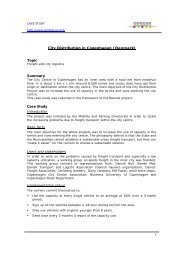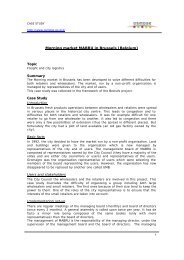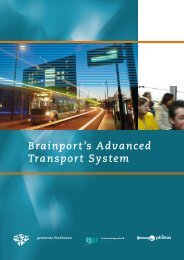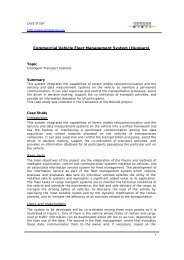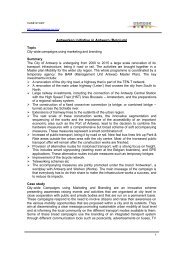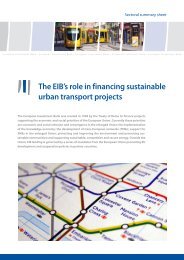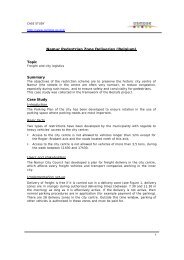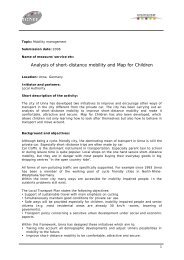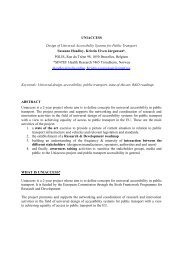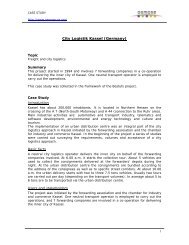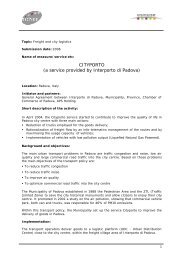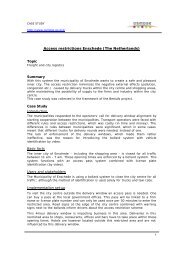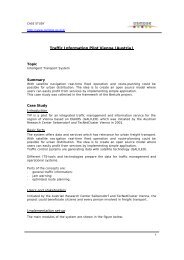Successful transport decision-making - Osmose
Successful transport decision-making - Osmose
Successful transport decision-making - Osmose
You also want an ePaper? Increase the reach of your titles
YUMPU automatically turns print PDFs into web optimized ePapers that Google loves.
Vol 1 - Table of Contents <br />
Next<br />
CONTEXTUAL FACTORS<br />
Institutional<br />
Institutional barriers often result from deficiencies in the cooperation between politicians, local authorities and other<br />
agencies that are involved in the project. Typical problems include: over-complex bureaucratic systems or conflicts of<br />
competence between different departments and agencies. The key to overcoming these barriers is first, to identify the<br />
source of the barriers and then to cultivate a culture of cooperation through dialogue. It may be necessary to create a<br />
structure for dialogue, as this may not be present within the existing hierarchy.<br />
Legal<br />
Legal barriers are amongst the most rigid barriers a project might face and can involve significant time delays. Through<br />
careful planning obvious constraints imposed by the law can be avoided. For example, the avoidance of conflicts with<br />
property rights by building infrastructure mainly on public land. Where legal barriers are encountered it is often necessary<br />
to revise the plan to conform with the existing laws, but on some occasions the <strong>transport</strong> project can become the catalyst<br />
for changing the law.<br />
Financial<br />
Financial constraints are a common occurrence for many projects and can become a serious barrier leading to delays,<br />
cancellation or a change of course for the project. There are two main issues concerning financial barriers. First, raising<br />
sufficient funds for the full life of the project and second, ensuring that the funds available are used appropriately and<br />
efficiently. Both these issues require good planning skills and the ability to predict and monitor financial flow data.<br />
PROCESS BARRIERS<br />
Management<br />
Management barriers often derive from project planning errors, such as unclear roles and responsibilities, blurred tasks, an<br />
unrealistic time plan, etc. This is often the hidden cause behind other barriers, such as running out of time and budget, poor<br />
communication, mutual mistrust, etc. Thus, a clear work plan is extremely important. It requires a manager and a project<br />
management team with relevant skills and experiences. If these qualities are not yet available in the project team, then this<br />
may require specific training or the use of external consultants. Good project management is based on a detailed yet flexible<br />
planning approach, enabling a quick response to unexpected barriers.<br />
Communication<br />
Communication barriers can exist at all levels and at any point in the <strong>decision</strong>-<strong>making</strong> process. These barriers can emerge<br />
within the project team, between project partners and with stakeholder groups. In all cases, overcoming these barriers<br />
requires a communication strategy that encourages dialogue that is open and informative. There are some specific<br />
approaches that can be employed to address communicational barriers. Within the project team it is important to ensure<br />
that there are clear definitions of roles, responsibilities, tasks and <strong>decision</strong>-<strong>making</strong> powers. Communication barriers<br />
between project partners and stakeholders need to be addressed through the engagement strategy and by ensuring that<br />
all project partners follow the strategy.<br />
Potential problems<br />
A critical factor for the success of a <strong>transport</strong> <strong>decision</strong><strong>making</strong><br />
process is the ability to avoid, identify and<br />
overcome barriers.<br />
Avoiding barriers<br />
Clear roles and responsibilities should be assigned<br />
in the project team to avoid confusing<br />
communication and unclear <strong>decision</strong>-<strong>making</strong><br />
structures.<br />
Sound analysis of the legal, financial and institutional<br />
framework, to avoid contextual restrictions appearing<br />
unexpectedly in the project’s life.<br />
Thorough identification and early involvement of key<br />
stakeholders. If stakeholders are not brought into the<br />
process at an early stage, there is a real risk that<br />
they will create more immovable barriers at a later<br />
stage in the project.<br />
A detailed work plan that shows all <strong>decision</strong>s to be<br />
taken, by whom and when, and clear tasks for the<br />
project staff.<br />
Allocation of sufficient funds for project management<br />
and engagement.<br />
Overcoming barriers<br />
Rigorous tracking of progress to identify barriers<br />
early on. An early warning system should result in a<br />
quicker and more efficient solution to overcome the<br />
barriers.<br />
Ensure that you have identified the real cause of the<br />
barrier, as otherwise efforts to resolve the problem<br />
will have been wasted.<br />
It is not always possible to achieve complete<br />
consensus, but having better informed stakeholders<br />
is more likely result in the acceptance of compromise<br />
solutions.<br />
Set aside a contingency budget to deal with barriers<br />
as they arise.<br />
57



